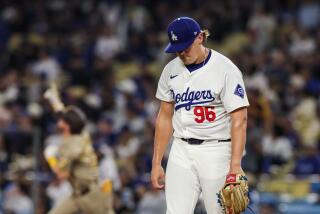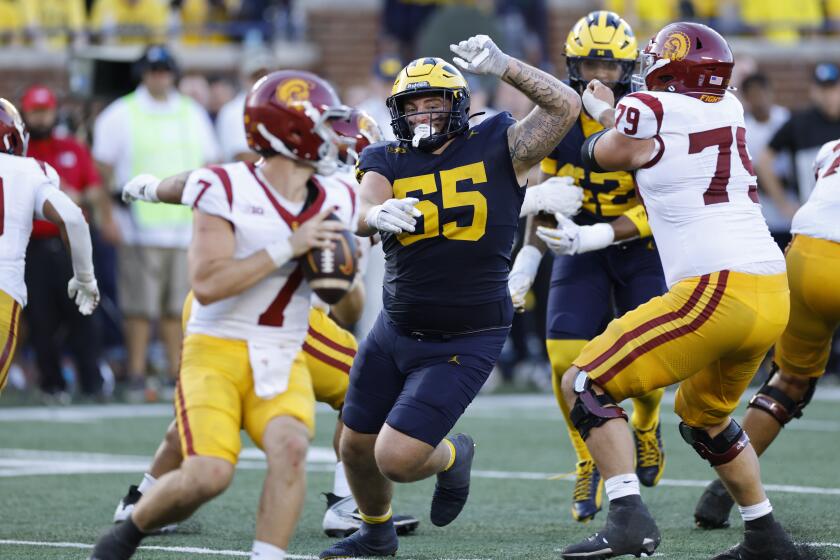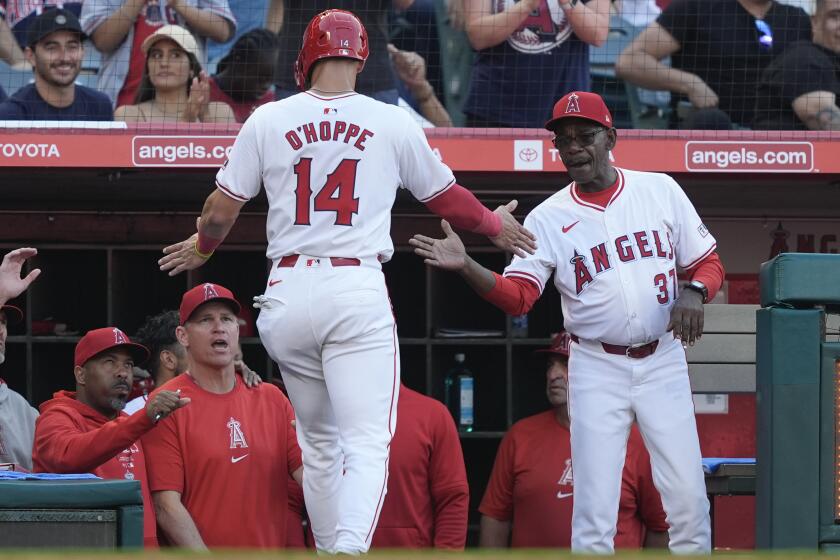UFC hits a rougher patch
Last summer, as the Ultimate Fighting Championship prepared for its 100th event, its owners were poised to celebrate that the combat sport of choice was no longer boxing but mixed martial arts.
Things have changed a bit.
Today, fight fans are whetting their appetites for the most anticipated bout in years. And it’s boxing that has the buzz because of the Manny Pacquiao-Floyd Mayweather Jr. mega-fight scheduled for March.
And the UFC? It’s been hit with a slew of injuries to key fighters and other negatives that have watered down its recent events.
In July, UFC 100 generated a live gate of more than $5 million in Las Vegas and an estimated 1 million-plus pay-per-view buys. Three of the key fighters that night were heavyweight champion Brock Lesnar, welterweight champion Georges St-Pierre and top light-heavyweight contender Dan Henderson.
None of the trio has fought since then: Lesnar because of a serious illness, St-Pierre because he’s recovering from elbow surgery, and Henderson because of the expiration of his contract. “We’ve had some bad luck over the last few months,” UFC owner Lorenzo Fertitta said.
Lesnar contracted mononucleosis, then received a diagnosis of a severe intestinal infection that required surgery, and there is no date for his return. The absence of Lesnar, a former World Wrestling Entertainment star, is so significant that Fertitta and UFC President Dana White have scheduled an interim heavyweight title fight in March.
Indeed, Fertitta and White have spent the second half of this year rescheduling events on the fly.
UFC’s main event in Las Vegas for November was supposed to be Lesnar against Shane Carwin. After Lesnar became ill, UFC was forced to showcase a rematch of light-heavyweights, Tito Ortiz, in his comeback fight, against former champ Forrest Griffin, who’d lost his last two fights.
The Nevada State Athletic Commission reported that the live gate sales for that November card were $2 million lower than UFC 100. And UFC distributed 3,898 complimentary tickets -- many to military members -- an indication of the difficulty it had in filling the arena.
“It’s been a challenge working through this,” Fertitta said.
Typically, UFC’s New Year’s Day and Super Bowl weekend cards are big events, but both cards for 2010 look weaker than usual.
Originally, the delayed Lesnar-Carwin bout was the headliner for the Jan. 2 event in Las Vegas, but that was scratched because of Lesnar’s illness. It was replaced by another heavyweight bout, between Antonio Rodrigo Nogueira and Cain Velasquez. Then Nogueira pulled out after getting a staph infection, and now a bout featuring former light-heavyweight champion Rashad Evans and Thiago Silva is the main event.
Another fighter missing from the January card is respected heavyweight Gabriel Gonzaga, who also has a staph infection.
Meanwhile, the Feb. 6 event on Super Bowl weekend has lost some of its gloss. It was supposed to feature a middleweight title fight with UFC’s most gifted fighter, champion Anderson Silva. But Silva is recovering from elbow surgery. Instead, UFC will offer a suspect match of aging light-heavyweights, Randy Couture and Mark Coleman.
Is the sport too taxing on its fighters?
“I believe [mixed martial arts] goes too far, it’s too violent and results in too many injuries,” said Ron Scott Stevens, former head of the New York State Athletic Commission, a state that doesn’t sanction MMA fights. “The rules that New York and California adopted for boxing in the 1920s still exist, and those rules say no to almost all of the things MMA says yes to. The choking, the hitting, the kicking that wasn’t termed safe or sportsmanlike back then I still don’t believe are.
“There are a lot of injuries in MMA -- orthopedic and worse,” he said.
Fertitta disagrees. “Look at the big names from when we’ve bought this company [Ortiz, Couture, lightweight champion B.J. Penn] who are still around,” he said. “We’ll be back.”
Heavyweight Frank Mir, who lost to Lesnar at UFC 100 and will fight Carwin in the interim title fight in March, admits the physical requirements of MMA don’t allow its fighters to play through injuries, as can occur in other sports.
“You can’t just say you’ve got a bad knee or bad ankle and tape it up,” Mir said. “Every part of your body is used -- and attacked. You can ask if it’s too violent, but is football too violent? No one’s going to pay to watch flag football.”
The cluster of injuries and staph issues is happening at an odd time, Mir said, given that increased salaries for UFC fighters allow them to pay for improving training. “We’re better now about reserving ourselves [and] using 16-ounce gloves in sparring,” he said. “We’re trying to be as intelligent as possible.”
White strongly insists the quality in his stable of 250 fighters remains high and he assured that the January and February cards will be highly competitive and entertaining.
“You have injuries in athletics,” Fertitta said. “Look at that NFL injury list. It’s massive.”
Fertitta also defended his sport’s long-term future, saying that boxing musters but one big fight of the year compared with UFC’s monthly offering of deeper cards.
“By May, mid-next year, we’re going to have some incredible opportunities and some mega-blockbusters coming,” Fertitta said. “I’m not concerned about boxing having a big fight. That sport’s not consistent, not the month-in, month-out threat that we are.”
More to Read
Go beyond the scoreboard
Get the latest on L.A.'s teams in the daily Sports Report newsletter.
You may occasionally receive promotional content from the Los Angeles Times.











